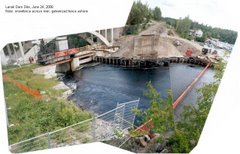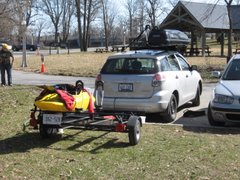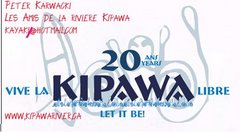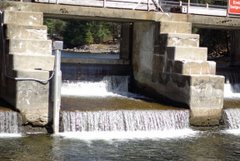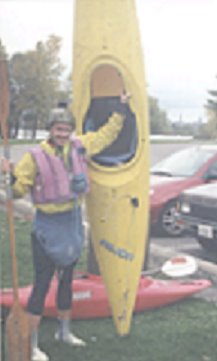Edited by Peter Karwacki
Friday, October 18, 2013
Jaculmoco Mexico Conundrum
Jim Coffey, esteemed whitewater leader appeals to adventure travelers to go to Jacumulco.
A story about the destruction of recreational whitewater in favor of other societal values such as job creation, power generation, water control
One approach: set a good example with river cleanups
Paddlers encounter trash washed downstream from a local community garbage dump:

A story about the destruction of recreational whitewater in favor of other societal values such as job creation, power generation, water control
One approach: set a good example with river cleanups
Paddlers encounter trash washed downstream from a local community garbage dump:

Thursday, October 17, 2013
What would a Green Party Platform for any candidate look like?
A work in progress
Democracy in the 21st Century
 A
system of voting that allows proportiona control to a party in proportion to the vote
A
system of voting that allows proportiona control to a party in proportion to the vote
 Create a strong economy with the strongest environmental law
Create a strong economy with the strongest environmental law
 Support for SMEs and small business is central to our government’s economic strategy
Support for SMEs and small business is central to our government’s economic strategy
 Pursue trade without sacrificing sovereignty
Pursue trade without sacrificing sovereignty
 Restore Canada’s strong
international reputation
Restore Canada’s strong
international reputation
Our Westminster parliamentary democracy
– should be true to our traditions.
Democracy in the 21st Century
A Green Speech From The Throne
1. Canada is a
Constitutional monarchy.
Canada is a Westminster Parliamentary
democracy which is why I read a speech filling
the role of stand-in monarch.
The Speech from the Throne, prepared by
the majority in the House of Commons
represents the the fundamental principles of legal
governance, going back to 1215 and Magna Carta.
2. Government is only
legitimate by consent of the governed.
We meet in the Senate chambers, the Canadian version of the House of
Lords and purview of monarchy, following the ritual lone walk by the
Senate’s Usher of the Black Rod to visit the House of Commons.
The prime minister stands with other Members of Parliament.
The prime minister stands with other Members of Parliament.
Democracy lies between corporate rule,
totalitarianism and hyper-partisan manipulation. Decisions by a prime minister to shut down
the House, prorogation of parliament are unconstitutional. To preserve a real democracy,
we need to remember fundamental principles:
All MPs are equal, stand as representatives of the people of the communities found in their electoral districts.
Lets engage Canadian youth in the life of our nation and in decisions about their future.
The Citizens First Agenda.
Eliminate the the “winner take all” or “First Past the Post” system with a proportional representation.
Repeal changes disadvantage voters without a driver’s license and a stable address who have given up driving. Enumerate eligible voters, and we need to reduce to zero the risk of citizens entitled to vote being turned away from their polling place due to a technicality.
- To be legitimate, government must exist by consent of the governed;
Parliament is supreme; - The prime minister reports to parliament and not the other way around.
All MPs are equal, stand as representatives of the people of the communities found in their electoral districts.
Restoring a Healthy Democracy
2017 will be the150th anniversary of ConfederationLets engage Canadian youth in the life of our nation and in decisions about their future.
The Citizens First Agenda.
Eliminate the the “winner take all” or “First Past the Post” system with a proportional representation.
Repeal changes disadvantage voters without a driver’s license and a stable address who have given up driving. Enumerate eligible voters, and we need to reduce to zero the risk of citizens entitled to vote being turned away from their polling place due to a technicality.
Place advertising limits
on political parties outside of writ periods.
Prohibit use of the airwaves for paid political
advertising, and require broadcasted public interest messages focusing
on advancing understanding of the various parties’ positions on issues
The requirement for the leader’s signature on the nomination papers of candidates will be replaced with the signatures of local executives, where an Electoral District Association exists, and where one does not, the signatures of other local members will suffice.
Allow members of an elected caucus of any parliamentary party to initiate a leadership review. These changes are intended to rebalance the powers of leaders of political parties with checks and balances
Set the budget for the operation of the Prime Minister’s Office as a fixed proportion of GDP.
Diversify the Canadian economy, through more value chains and more value added in relation to all natural resource exports.
Set shared goals for energy security, maximizing jobs, and the transition to a low-carbon economy. Phase out coal-fired power plants
Make significant improvements in transportation, waterworks, and other key infrastructure.
Including:
where the food has been produced and how it was produced.
Labelling to identify genetically modified foods will allow those who wish to eat GMO foods to locate them on their supermarket shelves and those who want to avoid them to do so.
Citizens have the right to review any scientific research conducted by independent government scientists. All such research should be in the public domain.
Restore evidence-based decision-making.
Make the Parliamentary Budget Office a stand-alone and properly funded operation, separate from the Library of Parliament. The Parliamentary Budget Officer will be an Officer of Parliament.
All government operations should be transparent including all spending by MPs and Senators.
Ensure an independent, professional, non-partisan public service – free of partisan interference. No public servant should fear being pressed to assemble “facts” in support of a previously set course.
Encourage entrepreneurial spirit and assist the commercialization of new technologies. Support for Small and Medium Enterprises (SMEs) and small business. Ensure all government bills are assessed for their impact on small business and SMEs.
Reduce the persistent unemployment rate among Canadian youth. Reverse the punitive Employment Insurance changes that make life more difficult for those in seasonal industries.
We will work with the national Ombudsman for Victims of Crime to improve supports for victims of violent crime and we will improve the rigor of laws to protect investors from white-collar crime bringing to justice those who set out to cheat seniors of their savings.
Launch a national inquiry into the missing and murdered aboriginal women of Canada. Without waiting for the results of that investigation we will create better tools for law enforcement, such as a national DNA data bank for victims of crime, to be cross-referenced with data banks of the missing.
The elimination of poverty is critical with 0.7% GDP to Official Development Assistance.
The requirement for the leader’s signature on the nomination papers of candidates will be replaced with the signatures of local executives, where an Electoral District Association exists, and where one does not, the signatures of other local members will suffice.
Allow members of an elected caucus of any parliamentary party to initiate a leadership review. These changes are intended to rebalance the powers of leaders of political parties with checks and balances
Set the budget for the operation of the Prime Minister’s Office as a fixed proportion of GDP.
Justice for First Nations, Inuit and Metis
First Nations education, housing and provision of clean water remain unfinished priorities. The rights and responsibilities to respect indigenous peoples’ decision-making on their traditional territories requires a serious review. True and meaningful consultation is required.Tackling the Climate Crisis
Tackle the single biggest threat to our collective future – the climate crisis with a sensible transition to reduced dependence on fossil fuels ending the subsidizing of fossil fuels and we will place a price on carbon.Diversify the Canadian economy, through more value chains and more value added in relation to all natural resource exports.
Set shared goals for energy security, maximizing jobs, and the transition to a low-carbon economy. Phase out coal-fired power plants
Make significant improvements in transportation, waterworks, and other key infrastructure.
Restoring Environmental Laws
Restore the Canadian Environmental Assessment Act, Fisheries Act and the Navigable Water Protection Act and integrate sound environmental policy in all levels of government decision-making.Rights to Information
Effective citizens require sound information. This means that citizens have a right to know what is in their foods.Including:
where the food has been produced and how it was produced.
Labelling to identify genetically modified foods will allow those who wish to eat GMO foods to locate them on their supermarket shelves and those who want to avoid them to do so.
Citizens have the right to review any scientific research conducted by independent government scientists. All such research should be in the public domain.
Restore evidence-based decision-making.
Make the Parliamentary Budget Office a stand-alone and properly funded operation, separate from the Library of Parliament. The Parliamentary Budget Officer will be an Officer of Parliament.
All government operations should be transparent including all spending by MPs and Senators.
Ensure an independent, professional, non-partisan public service – free of partisan interference. No public servant should fear being pressed to assemble “facts” in support of a previously set course.
Growing a Healthy Economy
Create opportunities in the cleantech sector, and reduce waste of energy. Grow sectors of our economy in many different regions of Canada, while maintaining resource-based activity in Alberta.Encourage entrepreneurial spirit and assist the commercialization of new technologies. Support for Small and Medium Enterprises (SMEs) and small business. Ensure all government bills are assessed for their impact on small business and SMEs.
Reduce the persistent unemployment rate among Canadian youth. Reverse the punitive Employment Insurance changes that make life more difficult for those in seasonal industries.
Trade and investment
Define“national security” in the Investment Canada Act with exacting cost-benefit analysis of the class of agreements called Foreign Investment Protection and Promotion Agreements (FIPAs). Ensure a clear communication of Canada’s interests and pursue trade, without sacrificing sovereignty through flawed FIPAs.A Fairer Society
Review all legislation and particularly the Criminal Code to remove mandatory minimums. We will enhance law enforcement resources, freeing up limited time and money by legalizing, regulating and taxing cannabis. We will restore the Law Reform Commission and ask for a review of the recent changes in criminal law as well as immigration and refugee law to ensure they are charter compliant.We will work with the national Ombudsman for Victims of Crime to improve supports for victims of violent crime and we will improve the rigor of laws to protect investors from white-collar crime bringing to justice those who set out to cheat seniors of their savings.
Launch a national inquiry into the missing and murdered aboriginal women of Canada. Without waiting for the results of that investigation we will create better tools for law enforcement, such as a national DNA data bank for victims of crime, to be cross-referenced with data banks of the missing.
Protecting Canadian Health Care
Hold talks with the provincial and territorial governments to find ways to reduce rising costs, particularly through controlling the price of pharmaceutical drugs. A national pharmacare programme, and aTherapeutics Initiative.Restoring our global reputation
My government commits to multilateralism, engaging, rather than shunning the world, diplomacy, peace-keeping and human rights around the world.The elimination of poverty is critical with 0.7% GDP to Official Development Assistance.
Putting Citizens First
Reduce partisanship and competition in political discourse and finding ways to work together for the betterment of all is central.Kipawa Rare Earths project request for a provincial environmental assessment and public consultations (BAPE)
Kipawa Rare Earths project request for a provincial environmental assessment and public consultations (BAPE)
Christina Moreau (savekipawalake@gmail.com)
yfblanchet-john@assnat.qc.ca
ministre@mrnf.gouv.qc.ca,
kipawa@mrctemiscamingue.qc.ca,
arnaud.warolin@mrctemiscamingue.qc.ca
harrystdenis@wolflakefirstnation.com
madeleine.paul@evfn.ca
Minister@ec.gc.ca
meallaire@snapqc.org, apart@tlb.sympatico.ca
info@miningwatch.ca, ramsey@miningwatch.ca
sierraclub.qc@gmail.com
gchapadeau-rnt@assnat.qc.ca
info@actionboreale.org
webmaster@cape.ca
info@aqlpa.com
ere@uqam.ca
fr@fondationrivieres.org
info@atquebec.org
conservons@naturequebec.org
svp.pollution@gmail.com
Mr. Yves-François Blanchet
Minister of Sustainable Development,
Environment
Wildlife and Parks, Province of
Quebec
Marie-Guyart, 29th Floor
675 boul. René-Levesque East
Quebec, Quebec G1R 5V7
In regards to: Request for a provincial environmental assessment and
public consultations (BAPE) for the proposed Kipawa Rare Earths project by
Matamec Explorations Inc.
Dear Mr. Blanchet:
Please find attached the signatures and
comments from the petition http://www.change.org/petitions/minister-of-natural-resources-quebec-protect-kipawa-lake.
This petition states that the risks of the proposed Kipawa Rare Earths project
are too great to allow it to proceed. Currently 2,543 individuals
(Abitibi-Temiscaming residents, business owners, cottage owners, seasonal
residents, tourists and other lake users) agree and have signed online, in
addition we have received 55 paper signatures (also attached) giving a total of
2598 signatures to date in opposition of this project.
The company, Matamec, has claimed and
continues to claim social acceptability. This petition, the peaceful protests
which took place on September 4th, 2013 in Laniel, Kipawa and
Temiscaming, the petition by A.P.A.R.T. (association pour l’avenir des
ressources temiscamiennes) as well as a
large Facebook community (over 1,000 ‘likes’ on https://www.facebook.com/SaveKipawaLake
and almost 4,000 members of https://www.facebook.com/groups/ProtectKipawaLake/)
prove otherwise. This project is not socially accepted.
The company has not been very forthcoming
in explaining the risks of the project to the public when questioned. In
addition, rare earth mining is new to Canada. It poses additional risks to the environment,
animals, plants, fish, air and water quality. In additional to those risks
present with other types of mining the fact remains that the dangers of the
rare earth ores themselves are not yet understood. One thing is clear, to date,
rare earth mining has never been carried out in a safe manner. In both China
and the United States there have been major environmental consequences and
disasters associated with this type of mining and in China also extreme human
health issues. For scientific and objectively sound information on the risks of
rare earth mining I encourage you to see the United States EPA publications
which can be accessed via the following links http://www.miningwatch.ca/sites/www.miningwatch.ca/files/epa_reportonrareearthelements1.pdf
and http://www.miningwatch.ca/sites/www.miningwatch.ca/files/epa_ree_report_dec_2012.pdf
For these reasons it is imperative that
the public be completely informed and have the maximum opportunity for input.
This cannot be done without a full provincial environmental assessment and
public consultation process in Quebec (BAPE).
Regardless of the amount of ore extracted
per day, whether 4,000 or 7,000 the effects are likely to be similar, the
difference is simply a matter of scale. In addition, allowing this project to
proceed without the full studies is a legal loop-hole whereby the company can
open with a less rigorous approval process and then increase their production
after the fact. Matamec has already alluded to the fact that they may do so in
the following press release http://www.proactiveinvestors.com/companies/news/48409/matamec-aims-to-boost-kipawa-project-economics-as-rare-earths-dynamics-improve-48409.html
Where Mr. Miller states “.. there is potential to increase production higher”
In addition the Metal Mining and Effluent
regulations do not limit the release of several of the potentially harmful
substances that could be released during rare earth mining. At the time that many
of these mining laws were written rare earth mining was not being carried out.
Furthermore the Ministry of Sustainable
Development, Environment, Wildlife and Parks and the Province of Quebec have
recently announced their plans to proceed with the creation of the Opemican Park
project situated on the Kipawa Lake and Lake Temiscaming, both of which are
located downstream of the proposed mine site. For this park to be worth the
investment, it must attract visitors. How many individuals will want to
vacation downstream of a potentially toxic and radioactive rare earth mine? If
you take a moment and look through the comments provided by the petition signers
many tourists are already stating that although they love the Kipawa area and
have been visiting for generations, should this mine project be allowed to
proceed they will take their families and money elsewhere. Tourism is one of the
few long term stable industries in the area. Kipawa Lake is one of the most
beautiful lakes in Canada. It would be devastating for it to be lost due to a short
term economic gain to few from a potentially destructive mining operation that
will benefit few of the local population.
Kipawa Lake is an important tourist
destination, an important source of drinking water to local communities and
those downstream along the Ottawa River. It also has a strong cultural and
historic significance to local First Nations communities. I beg that you put
these very important uses ahead of a potentially devastating short term
financial gain for few. The first step in doing so Mr. Blanchet is to give the
public more information and a voice. You can do so by requiring the project to
undergo a full environmental study and public consultation. Please take into
consideration these signatures in support of and in addition to those received
from A.P.A.R.T.
Sincerely,
Christina
Moreau, BSc, BEd
MSc in Fisheries and Aquatic Science (in
progress)
cc:
Martine Ouellet,
ministre des Ressources naturelles du Québec
Pauline Marois,
première ministre du Québec
Leona Aglukkak,
Minister of Environment, Government of Canada
Norman Young,
Mayor, Municipality of Kipawa
Arnaud Warolin,
Préfet MRC Temiscamingue
Madeleine Paul,
Chief, Eagle Village First Nation
Harry St-Denis, Chief,
Wolf Lake First Nation
Christine Moore,
Abitibi-Témiscamingue,
Member of Parliament, Deputy critic for energy and natural resources
Association pour l’avenir des ressources
temiscamiennes (APART)
Coalition pour que le Québec ait meilleure mines
Ottawa River Keeper
Mining Watch Canada
CPAWS Ottawa
River Valley
Les amis de la
rivière Kipawa
Sierra Club Québec
Gilles
Chapadeau, député de Rouyn-Noranda-Témiscamingue
Action boréale
Abitibi-Témiscamingue (ABAT)
Association canadienne
des médecins pour l’environnement (ACME)
Association
québécoise de lutte contre la pollution atmosphérique (AQLPA)
Centre de
recherche en éducation et formation relatives à l'environnement et à
l'écocitoyenneté
Fondation
Rivières
Les AmiEs de la
Terre du Québec
Nature Québec
Société pour la
nature et les parcs (SNAP-Québec)
Société pour
vaincre la pollution (SVP)
Subscribe to:
Comments (Atom)
Useful Links
- Mount Gox - Bitcoin exchange
- Reggie Middleton's Rapier Analysis
- Ontario Rivers Alliance
- Geodesic Dome Construction
- Canadian Disaster Preparedness
- Globe and Mail
- Chris' The Weekly Telegram
- Michael Rupert of CollapseNet
- Max Keiser
- Nicole Foss Blog - the automatic earth
- Peak Moment Discussions
- Scotia Mocatta Bullion Store
- Dimitry Orlov - Peak Moment Discussions
- Jims's ISFCR Blog
- Jenny Right Side Blog
- Scott Sorensen
Alternative Energy Sites I like
The Queen is not amused!

http://www.ispeakforcanadianrivers.ca/
The Ashlu river: it could happen to you

Whitewater Ontario

Working Hard to Protect Canada's Paddling Resources
Whitewater Ontario - Mission Statement
It is Whitewater Ontario’s mission to support the whitewater paddling community through the promotion, development and growth of the sport in its various disciplines.
We accomplish this through the development of events, resources, clubs, and programs for personal and athletic development, regardless of skill level or focus, to ensure a high standard of safety and competency;
We advocate safe and environmentally responsible access and use of Ontario’s rivers.
Whitewater Ontario is the sport governing body in the province, and represents provincial interests within the national body Whitewater Canada and the Canadian Canoe Association
http://www.whitewaterontario.ca/page/mission.asp
Kipawa, Tabaret, and Opemican
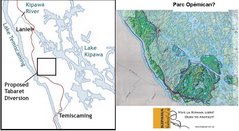
If Hydro Quebec is not actively pursuing Tabaret what is that bite out of Opemican for?
Kipawa Dam: After

Laniel Dam at 2006 Rally
Where is the Kipawa
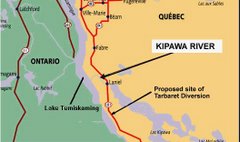
Kipawa flows into lake Temiskamingue, running from Kipawa Lake, under hwy 101 in Quebec
Kipawa Dam

laniel dam at 2004 River Rally
Tabaret is a Bad Idea
About the Kipawa
The best thing paddlers can do to help the cause of the Kipawa:
1. attend the rally and bring others including non paddlers to attend and buy beer and have fun
2. write your MP /MNA and raise the issue and post your objections -1 letter = 200 who didn't write
3. Write Thierry Vandal the CEO of Hydro Quebec strongly opposing the 132 MW standard decrying the use of "diversion" as the most environmentally inappropriate method of power production
4. Write Jean Charest, Premier of Quebec protesting that either the algonquin or the tabaret project will eliminate all other values on the Kipawa River by turning it into a dry gulch.
5. See if you can get other allied groups interested by showing your own interest, ie the Sierra Defense Fund, Earthwild, MEC, and so on.
6. Demand further consultation
7. Currently we are at the point where we need to sway public opinion and raise awareness.
However, if all else fails, don't get mad, simply disrupt, foment, and protest . The Monkey Wrench Gang.
Have you read Edward Abbey?
Important Addresses
CEO,Hydro Québec, 75 boul René Levesque, Montreal, P.Q., H2Z 1A4Caille.andre@hydro.qc.ca
The best thing paddlers can do to help the cause of the Kipawa:
1. attend the rally and bring others including non paddlers to attend and buy beer and have fun
2. write your MP /MNA and raise the issue and post your objections -1 letter = 200 who didn't write
3. Write Thierry Vandal the CEO of Hydro Quebec strongly opposing the 132 MW standard decrying the use of "diversion" as the most environmentally inappropriate method of power production
4. Write Jean Charest, Premier of Quebec protesting that either the algonquin or the tabaret project will eliminate all other values on the Kipawa River by turning it into a dry gulch.
5. See if you can get other allied groups interested by showing your own interest, ie the Sierra Defense Fund, Earthwild, MEC, and so on.
6. Demand further consultation
7. Currently we are at the point where we need to sway public opinion and raise awareness.
However, if all else fails, don't get mad, simply disrupt, foment, and protest . The Monkey Wrench Gang.
Have you read Edward Abbey?
Important Addresses
CEO,Hydro Québec, 75 boul René Levesque, Montreal, P.Q., H2Z 1A4Caille.andre@hydro.qc.ca
Tabaret is a Bad Idea (Part Two)
Les Amis de la Riviere Kipawa is poised to use an application to the Federal Court to issue a Writ of Mandamus to ensure the Minster does what he is supposed to do, protect the public's right to navigate the water control structure at Laniel, Quebec using the Navigable Waters Protection Act. (see http://www.kipawariver.ca/)
In the now gutted Navigable Waters Protection Act lay the means by which the Minister of Transport could keep the public right of passage down our great Canadian Heritage, our rivers and streams which are threatened especially by resource corporations and power brokers such as Hydro Quebec.
These powerful entities continue to petition that 'this' river or 'that' stream is not navigable and therefore not protectable.
I don't say that dams and bridges should not be built, only that if they are, historical navigation rights should be considered and preserved by making reasonable accommodations for recreational boaters.
It is the Minister of Transport, in exercising the right to allow or disallow work on or over a navigable waterway is what keeps boats and recreational boaters plying our waterways.
To many recent cases launched in the Federal Court concerning the Navigable Waters Protection Act, most recently the case of the Humber Environment Group of Cornerbrook Newfoundland versus the Cornerbrook Pulp and Paper Company indicates that the important oversight is not being faithfully performed. Have we really come to the point now where we must say "such and such a stream is one foot deep, possessing so many cubic feet per second flow and so on?" The answer to this is... YES!
The honourable Mr. Justice John A. O'Keefe, ruled that it had not been shown that the river was navigable. How convenient was that to the Minister? But either the Minister of Transport acts to protect our rivers and streams as a public right or he does not and that means rivers and streams currently enjoyed by kayakers and canoists.
Enough of the cheating, and double-talk. Canadians! our rivers and streams are our own, lets urge the Minister of Transport and the our government to protect them.
Peter Karwacki
In the now gutted Navigable Waters Protection Act lay the means by which the Minister of Transport could keep the public right of passage down our great Canadian Heritage, our rivers and streams which are threatened especially by resource corporations and power brokers such as Hydro Quebec.
These powerful entities continue to petition that 'this' river or 'that' stream is not navigable and therefore not protectable.
I don't say that dams and bridges should not be built, only that if they are, historical navigation rights should be considered and preserved by making reasonable accommodations for recreational boaters.
It is the Minister of Transport, in exercising the right to allow or disallow work on or over a navigable waterway is what keeps boats and recreational boaters plying our waterways.
To many recent cases launched in the Federal Court concerning the Navigable Waters Protection Act, most recently the case of the Humber Environment Group of Cornerbrook Newfoundland versus the Cornerbrook Pulp and Paper Company indicates that the important oversight is not being faithfully performed. Have we really come to the point now where we must say "such and such a stream is one foot deep, possessing so many cubic feet per second flow and so on?" The answer to this is... YES!
The honourable Mr. Justice John A. O'Keefe, ruled that it had not been shown that the river was navigable. How convenient was that to the Minister? But either the Minister of Transport acts to protect our rivers and streams as a public right or he does not and that means rivers and streams currently enjoyed by kayakers and canoists.
Enough of the cheating, and double-talk. Canadians! our rivers and streams are our own, lets urge the Minister of Transport and the our government to protect them.
Peter Karwacki
Tabaret is a Bad Idea (Part Three)
10 Reasons WhyTabaret is a Bad Idea1) Tabaret is too big. The station is designed to useevery drop of water available in the Kipawawatershed, but will run at only 44 percent capacity.We believe the Tabaret station is designed to usewater diverted from the Dumoine River into theKipawa watershed in the future.
2) The Tabaret project will eliminate the aquaticecosystem of the Kipawa River.The Tabaret project plan involves the diversion of a16-km section of the Kipawa River from its naturalstreambed into a new man-made outflow from LakeKipawa.
3) Tabaret will leave a large industrial footprint on thelandscape that will impact existing tourismoperations and eliminate future tourism potential.
4) The Tabaret project is an aggressive single-purposedevelopment, designed to maximize powergeneration at the expense of all other uses.
5) River-diversion, such as the Tabaret project, takinglarge amounts of water out of a river’s naturalstreambed and moving it to another place, is verydestructive to the natural environment.
6) The Kipawa River has been designated a protectedgreenspace in the region with severe limitations ondevelopment. This designation recognizes theecological, historical and natural heritage value ofthe river and the importance of protecting it.Tabaret will eliminate that value.
7) If necessary, there are other, smarter and morereasonable options for producing hydro power onthe Kipawa watershed. It is possible to build a lowimpactgenerating station on the Kipawa river, andmanage it as a “run-of-the-river” station, makinguse of natural flows while maintaining other values,with minimal impact on the environment.
8) The Kipawa watershed is a rich natural resource forthe Temiscaming Region, resonably close to largeurban areas, with huge untapped potential fortourism and recreation development in the future.Tabaret will severely reduce this potential.
9) Tabaret provides zero long-term economic benefitfor the region through employment. The plan is forthe station to be completely automated andremotely operated.
10) The Kipawa River is 12,000 years old. The riverwas here thousands of years before any peoplecame to the region. The Tabaret project will change all that.
Problems on a local River?
- There is more to do as well but you have to do your research and above all, don't give up.
- IN the meantime prepared a document itemizing the history of navigation of this spot and its recreational value. Use the Kipawa river history of navigation as a guide: see www.kipawariver.ca
- Under the Ministry of Environment guidelines you have a set period of time to petition the change under the environmental bill of rights, you may have limited time to take this action. But it involves going to court for a judicial review of the decision.
- 4. contact the ministry of natural resources officials and do the same thing.
- 3. contact the ministry of the environment and determine if they approved the project
- 2. determine if the dam was a legal dam, approved under the navigable waters protection act.
- 1. research the decision and timing of it to determine if an environmental assessment was done.
Minden Ontario
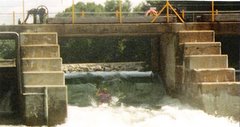
Gull River Water control at Horseshoe lake
A History of Navigation on the Kipawa River
Prior to the environmental assessment there was no signage at the Laniel Dam
T-Shirts Area: These are available now!

Send $25 and a stamped self addressed envelop for the Tshirt, and for the bumper sticker, a stamped and self addressed envelope with $5.00 for the bumper sticker to Les Amis de la rivière Kipawa, 80 Ontario St., Ottawa, Ontario, K1K 1K9 or click the link To purchase a Les Amis "T" contact Doug with the following information: Number of shirts:Sizes: Ship to Address: Method of Payment: cash, cheque and paypal, Shipto address:
Bumper Stickers Now Available

Get your bumper sticker and show your support for the Kipawa Legal Fund ! - send $5.00 in a Stamped, self addressed envelope to: Peter Karwacki Box 39111, Ottawa, Ontario, Canada, K1H 7X0






